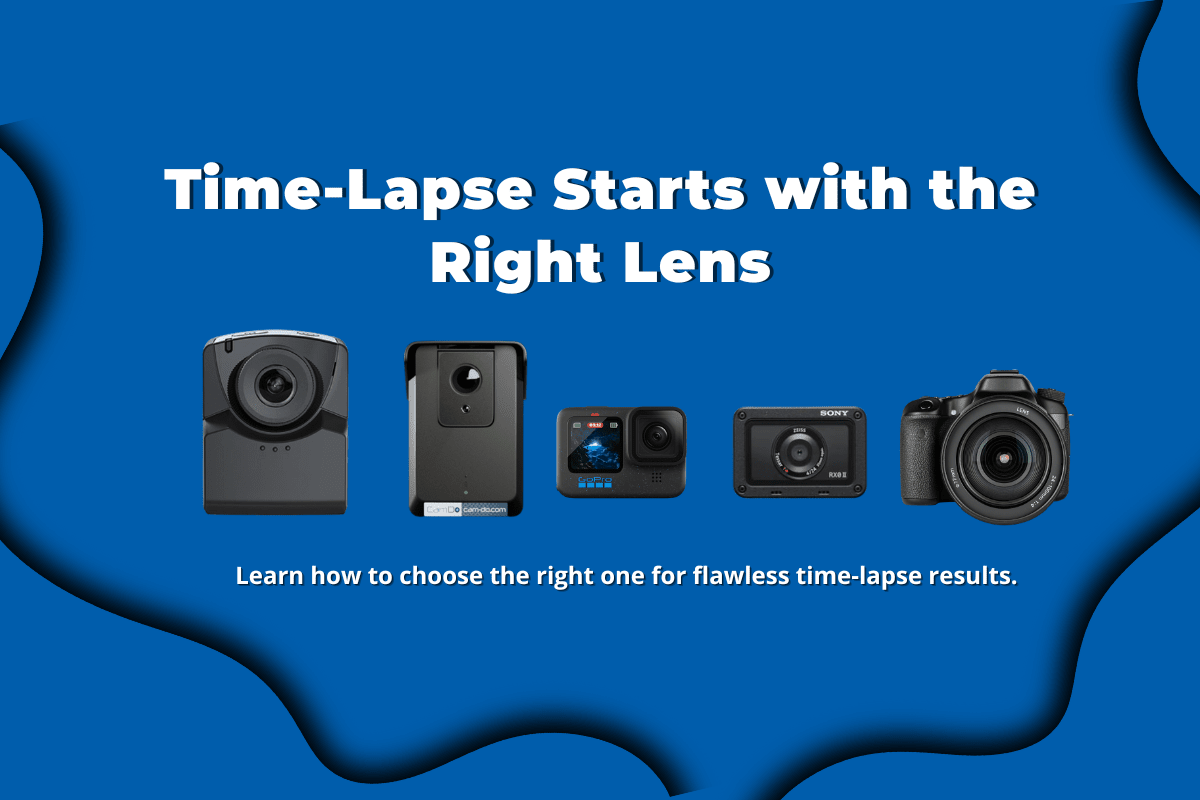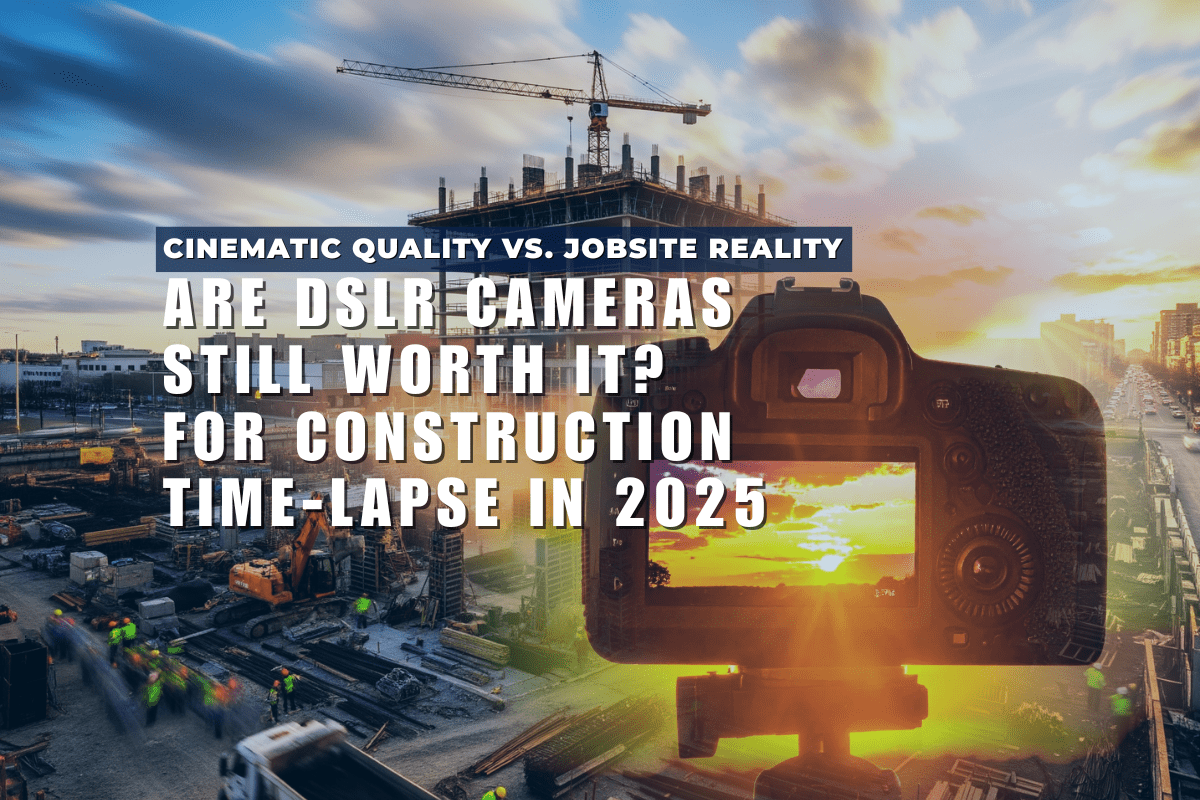Updated August 2025
Installing a time-lapse system on your construction site is one of the best ways to track progress, keep stakeholders informed, and create a lasting record of your project. But with so many camera options available, how do you know which one is the right fit?
Not all digital cameras are created equal when it comes to construction time lapse. Some are better suited for long-term deployments, while others shine in portability or image quality. Below are the key factors to consider when choosing your setup.
Key Factors to Consider
1. Length of Time
How long will your project run? A time lapse for construction typically spans months or even years. For these deployments, constantly swapping batteries or memory cards is impractical. A solar charging kit paired with automated cloud uploads eliminates the risk of missing footage and minimizes site visits.
2. Frame Rate & Intervals
The smoother your final video, the higher the playback frame rate. Most time-lapses are compiled at 30 fps. But the real decision lies in your shooting interval, the gap between photos. Too few frames and the footage feels choppy. Too many frames, and you’re storing unnecessary data. Modern systems simplify this by letting you adjust frame intervals and preview outcomes through online dashboards.
Pro tip: Use our time lapse calculator to select the interval based on your variables.
3. Storage & File Management
Thousands of images quickly consume storage space. While compression helps, today’s priority is reliable uploads and archiving. Systems that automatically send images to the cloud save you from worrying about memory cards or local storage limits.
4. Daytime vs. Nighttime Shooting
Construction activity usually happens in daylight, but projects don’t always stop as the sun goes down. Low-light performance matters. GoPro and Sony cameras have improved in this area, but for true night visibility, you’ll still need supplemental lighting.
Pro tip: CamDo’sDataLens camera includes strong low-light performance with a short-range IR illuminator, ideal for capturing evening progress. Still, remember thattime lapse cameras aren’t designed to replace security cameras, just as security cameras aren’t built for cinematic time lapse.
5. HD or 4K Resolution
Today, 4K is the standard for construction time lapse. It strikes the right balance between detail and file size, and it allows you to crop or zoom into parts of the frame during editing. While 1080p (HD) may still work for internal updates, 4K future-proofs your footage for marketing and stakeholder presentations.
6. Size and Weight
If you’re only shooting short sequences with a tripod, a lightweight setup might be enough. For long-term outdoor use, however, you’ll want a rugged, weather-sealed housing that integrates power and connectivity. Many systems now combine these components, making deployment easier than managing piecemeal accessories.
Camera Options: From Entry-Level to Professional
Low-End (Entry-Level Time Lapse Cameras)
Pros: Inexpensive, easy to set up.
Cons: Lower image quality and limited reliability for multi-month deployments.
High-End (DSLRs)
Pros: Impressive image quality, wide lens selection.
Cons: Significantly higher cost and diminishing returns for construction projects. DSLRs are often overkill, since most of their advanced features aren’t used in long-term time lapse.
Middle Ground (Best Balance for Construction Time Lapse)
GoPro HERO Series (HERO12 compatible)
-
Pros: Compact, durable, proven optics. A great balance of image quality and affordability.
-
Cons: Mediocre low-light performance compared to specialized options.
Sony RX0 II
-
Pros: Rugged build, premium Zeiss lens, strong low-light performance.
-
Cons: More expensive than GoPro, though still well below DSLR costs.
DataLens (CamDo’s All-in-One Solution)
-
Pros: 4K resolution, plug-and-play setup, built-in cellular connectivity, strong low-light performance with short-range IR. Designed for long-term outdoor projects with automated uploads to CloudX. The best value for money.
-
Cons: Purpose-built for time lapse, less flexible for traditional photography or video.
Why Cloud Connectivity Matters
No matter which camera you choose, pairing it withautomated image uploads and remote monitoring is a game-changer. CamDo’sCloudX platform gives you:
-
Automatic cloud uploads
-
AI-powered progress tracking and safety alerts
-
Latest-image access for quick updates
-
Easy video creation for reports and marketing
This saves trips to site, reduces the risk of lost data, and makes your footage more actionable.
FAQs
FAQs: Construction Time‑Lapse Cameras
1) Do I need 4K for construction time‑lapse?
For most projects, yes. 4K gives you room to crop and zoom while keeping detail.
2) Can I run a time‑lapse camera for months or years?
Yes. Use solar or continuous power and enable cloud uploads so images are never stuck on SD cards.
3) Is a DSLR worth it for construction time‑lapse?
Usually not. DSLRs cost much more and the quality gain is minor for documentation. Modern 4K systems meet most needs at lower cost.
4) What’s the best budget‑friendly option?
DataLens is the best value 4K time lapse at $999.
5) When should I choose a modular system like Sony RX0 II or GoPro HERO12?
When you want higher megapixels or lens flexibility for marketing‑grade content.
6) How do I pick a shooting interval?
It depends on the length of the project but a good start is 20 minutes for general progress. Shorten intervals such as 10 minutes for fast activity; lengthen for projects longer than 18 months.
7) Do I need Wi‑Fi or cellular?
For long projects, yes. Automated cloud uploads protect your record and reduce site visits.
8) What about low‑light or night shots?
Time‑lapse is daylight‑first. DataLens offers strong low‑light with a short‑range IR illuminator for evening capture, but it’s not a security system.
9) Can a security camera replace a time‑lapse camera?
No. Security cameras are built for live/continuous monitoring, not interval‑based capture optimized for smooth time‑lapse.
Final Thoughts
So, what’s the best camera for construction time lapse? It depends on your project’s length, environment, and budget. For many, the sweet spot lies in theGoPro HERO series, Sony RX0 II, or CamDo’s DataLens, depending on whether you value flexibility, premium optics, or all-in-one simplicity.
Ready to start your time lapse project?




